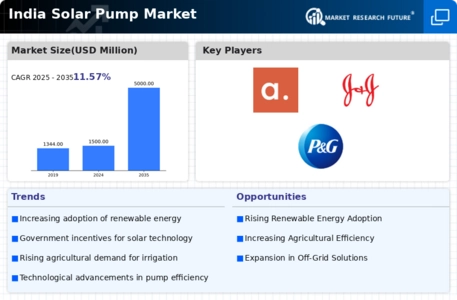Market Share
India Solar Pump Market Share Analysis
The India Solar Pump Market is influenced by a variety of market factors that collectively contribute to shaping its dynamics and growth trajectory. At the forefront is the increasing need for sustainable and decentralized energy solutions in India, particularly in rural and agricultural regions. The rising awareness of environmental concerns and the quest for energy independence drive the adoption of solar pumps as an eco-friendly alternative to traditional diesel and electric pumps. This commitment aligns with the Indian government's initiatives to promote clean energy and address energy access challenges, shaping the market landscape.
Economic considerations play a pivotal role in the market factors of the India Solar Pump Market. The decreasing costs of solar photovoltaic (PV) technology, coupled with government incentives and subsidies, enhance the economic viability of solar pumps. As solar pump solutions become increasingly cost-effective, farmers and rural communities are more inclined to invest in these sustainable alternatives. Economic feasibility is a critical factor for the widespread adoption of solar pumps, fostering technological innovation and market growth.
Government policies and regulatory frameworks are instrumental market factors that define the landscape of the India Solar Pump Market. The Indian government has implemented various schemes and financial incentives to promote solar pump adoption, including subsidies, concessional financing, and support for decentralized solar power projects. These policies are designed to stimulate investment, incentivize farmers, and create a supportive regulatory environment that fosters the scaling up of solar pump installations across the country.
Agricultural practices and the need for reliable water supply are significant market factors driving the adoption of solar pumps in India. Agriculture is a key economic sector, and farmers heavily depend on water for irrigation. Solar pumps offer a sustainable and cost-effective solution, providing farmers with a reliable source of energy for water extraction and irrigation. The integration of solar pumps supports agricultural productivity, influences market dynamics, and addresses water scarcity challenges in rural areas.
Technological advancements and innovation are pivotal market factors shaping the India Solar Pump Market. Continuous research and development activities focus on improving the efficiency and performance of solar pump systems, making them more adaptable to diverse agricultural and geographic conditions. Innovations in energy storage solutions, pump design, and smart technologies contribute to enhancing the overall feasibility and competitiveness of solar pump solutions in the Indian market.
Infrastructure development is a key market factor influencing the adoption of solar pumps in India. The successful deployment of solar pump systems necessitates a well-developed infrastructure, including solar panels, energy storage, and efficient water distribution networks. Government-led initiatives to enhance rural infrastructure contribute to the scalability of solar pump installations, shaping market dynamics and supporting the growth of solar-powered irrigation solutions.
Public awareness and acceptance are increasingly impactful market factors in the India Solar Pump Market. As awareness of climate change and environmental sustainability grows, there is a heightened demand for clean and renewable energy solutions. Public support for solar pump projects influences political decisions, regulatory frameworks, and market dynamics, creating a conducive environment for the widespread adoption of solar pumps in both rural and urban settings.
Financial considerations and investment trends are critical market factors shaping the India Solar Pump Market. The availability of financing, investments, and favorable lending conditions directly impact the affordability and accessibility of solar pumps for farmers. Government-backed financial schemes, collaborations with financial institutions, and the involvement of private sector players contribute to the overall funding landscape, influencing market dynamics and supporting the expansion of solar pump initiatives.
The India Solar Pump Market is characterized by a dynamic interplay of market factors, including economic considerations, government policies, agricultural needs, technological innovation, infrastructure development, public awareness, and financial trends. As these factors continue to evolve, the market is poised to play a pivotal role in India's efforts to promote sustainable agriculture, enhance rural electrification, and address water access challenges, contributing to the country's broader goals of achieving energy security and environmental sustainability.






Leave a Comment